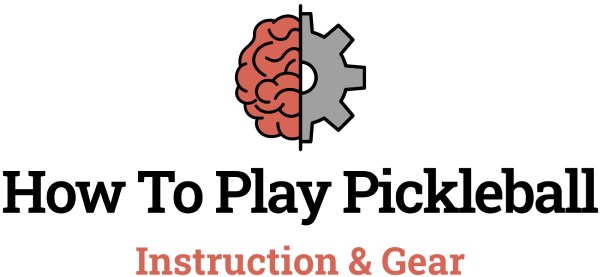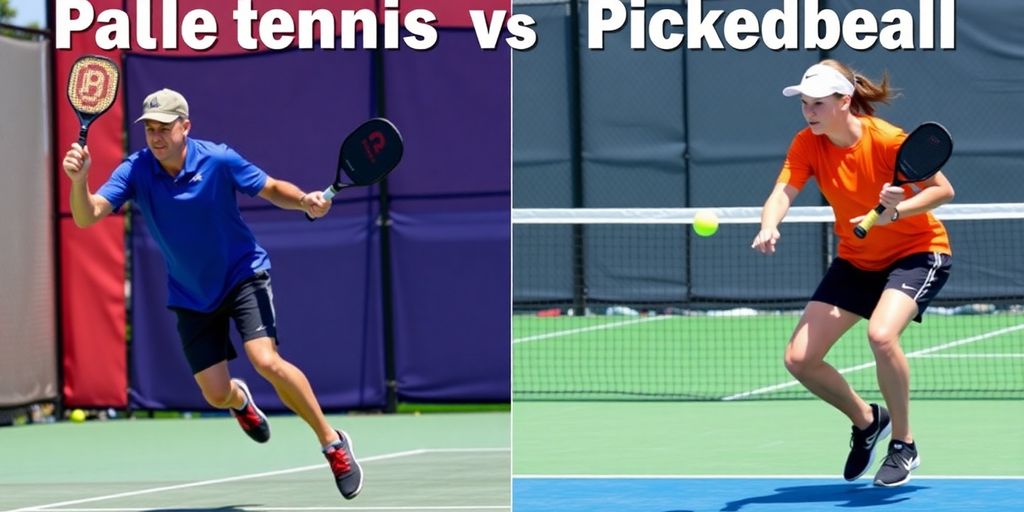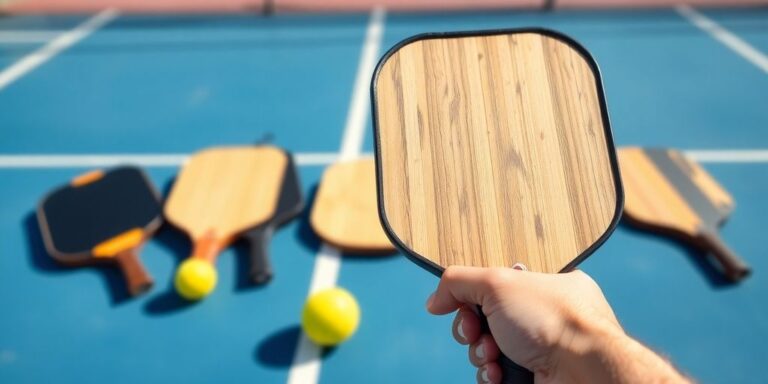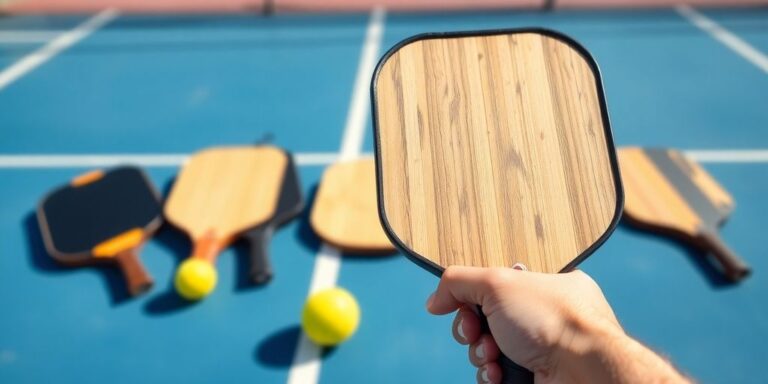If you’re trying to decide between paddle tennis and pickleball, you’re not alone. Both sports are gaining popularity and offer unique experiences on the court. While they may seem similar at first glance, there are some important differences that could make one sport a better choice for you. This article will break down the key features of paddle tennis vs pickleball to help you figure out which one fits your style and goals better.
Key Takeaways
- Paddle tennis and pickleball are both fun racket sports but have different gameplay styles.
- Pickleball is generally easier for beginners due to its smaller court and simpler rules.
- Paddle tennis matches tend to be longer and can offer a more intense workout.
- Both sports promote community and inclusivity, making them great for social play.
- Consider your fitness goals and how much time you can commit when choosing between the two.
Understanding Paddle Tennis and Pickleball

Overview of Paddle Tennis
Paddle tennis, sometimes called "pop tennis," is a simplified version of tennis played on a smaller court. It’s a fun, accessible sport that’s easier to learn than traditional tennis, making it great for beginners and people of all ages. The game uses solid paddles and a depressurized tennis ball, which slows down the pace of play. This allows for longer rallies and more strategic shot placement. Paddle tennis is often played on hard surfaces, like asphalt or concrete, and the net is lower than a tennis net. It’s a great way to get some exercise and enjoy some friendly competition without needing a ton of specialized equipment or training.
Overview of Pickleball
Pickleball is a sport that’s been exploding in popularity lately, and for good reason! It combines elements of tennis, badminton, and table tennis, making it easy to pick up but difficult to master. Players use solid-faced paddles to hit a perforated plastic ball over a net. The court is smaller than a tennis court, similar in size to a badminton court. One of the unique aspects of pickleball is the "kitchen," a non-volley zone near the net, which adds a strategic element to the game. It’s a social sport that’s easy on the joints, making it a great option for people of all ages and fitness levels. You can even find pickleball paddles designed for different skill levels.
Key Differences in Gameplay
While paddle tennis and pickleball share some similarities, there are some key differences in how they’re played. Here’s a quick rundown:
- Ball: Paddle tennis uses a depressurized tennis ball, while pickleball uses a perforated plastic ball, similar to a wiffle ball. This affects the speed and bounce of the ball.
- Paddle: Paddle tennis uses solid paddles, while pickleball also uses solid-faced paddles, but they can vary in material and weight.
- Court: While both are smaller than a tennis court, the dimensions differ slightly. Paddle tennis courts are generally a bit larger.
- The Kitchen: Pickleball has a non-volley zone (the kitchen) close to the net, which restricts volleying in that area. Paddle tennis does not have this rule.
The serve is also different. In pickleball, the serve must be underhand and hit below the waist. In paddle tennis, the serve can be overhand or underhand, depending on the rules of the specific league or tournament. Understanding these differences is key to choosing which sport is right for you. Paddle and pickleball are both fun, but offer distinct experiences.
Similarities Between Paddle Tennis and Pickleball
While paddle tennis and pickleball each have their own distinct flavor, they share some core similarities that make them appealing to a wide range of players. It’s easy to see why people often compare the two!
Court Dimensions
One of the most noticeable similarities is the court size. Both paddle tennis and pickleball are played on courts that are significantly smaller than a traditional tennis court. This smaller space makes the games more accessible to players who might not be able to cover the ground required in tennis. The reduced court size also tends to create faster-paced, more engaging games with lots of action near the net. This can be great for players who enjoy quick reactions and strategic net play. The smaller court size makes it easier to find engaging sport.
Equipment Used
Both sports use paddles instead of stringed rackets, which is a departure from tennis. These paddles are typically made from composite materials like graphite or fiberglass, offering a solid hitting surface. While there can be slight variations in paddle design, the fundamental concept is the same: a solid surface for striking the ball. Even the balls share similarities; both are typically plastic and have holes, though the size and number of holes can differ. You can find a game-ready pickleball paddles made of similar materials.
Scoring Systems
Both paddle tennis and pickleball employ scoring systems that are relatively easy to learn, especially for those familiar with tennis. While the specific point values and serving rules may differ, the basic principle of scoring points by hitting the ball in bounds and forcing your opponent to miss is consistent. This shared foundation makes it easier for players to transition between the two sports. The scoring is different enough to keep things interesting, but similar enough that you won’t be completely lost when trying a new game.
Both sports emphasize strategy and placement over raw power, making them accessible to players of all ages and fitness levels. This focus on finesse and tactics creates a more level playing field, where skill and smart play can often overcome physical advantages.
Differences in Gameplay Style
Pace of Play
Okay, so here’s the deal: paddle tennis and pickleball, while both played on smaller courts, have pretty different vibes when it comes to speed. Paddle tennis? It’s more like tennis’s chill cousin. The rallies can be long, and the pace is generally faster. Think more running, more swinging, and a game that keeps you moving. Pickleball, on the other hand, is often about finesse.
It’s not always about smashing the ball as hard as you can; it’s about placement and strategy. This difference in pace makes each sport appealing to different types of players. Some people love the cardio workout of paddle tennis, while others prefer the calculated movements of pickleball.
Types of Shots
In paddle tennis, you’ll see a lot of shots that are familiar if you’ve ever watched tennis. Serves, volleys, groundstrokes – the whole shebang. You can even hit with some topspin! Pickleball has its own unique set of shots, though. The ‘dink’ is a soft shot near the net, and the ‘kitchen’ rule (no volleying inside a certain zone) changes how you approach the net. These differences in shot types really change the game. Here’s a quick rundown:
- Paddle Tennis: Serves, groundstrokes, volleys, overheads.
- Pickleball: Dinks, volleys (outside the kitchen), groundstrokes, lobs.
- Both: The drop shot is used in both sports.
Player Strategy
Strategy is where these two sports really diverge. Paddle tennis strategy often mirrors tennis, with players trying to control the baseline and dictate play with powerful shots. Pickleball? It’s all about court positioning and smart shot selection. The non-volley zone pickleball strategy forces players to be creative and patient. You’ll see a lot of doubles play in pickleball, which emphasizes teamwork and communication. Paddle tennis can be singles or doubles, but the court coverage demands are higher. Ultimately, pickleball is more about outsmarting your opponent, while paddle tennis can be more about overpowering them.
Here’s a quick comparison:
| Feature | Paddle Tennis | Pickleball |
|---|---|---|
| Primary Strategy | Baseline control, power shots | Court positioning, dinking, strategic volleys |
| Court Coverage | More demanding | Less demanding |
| Teamwork | Important in doubles, but less emphasized | Highly emphasized, especially in doubles |
| Shot Selection | Power and placement are both important | Placement and spin are key |
So, whether you prefer a power game or a strategic one, both paddle tennis and pickleball distinct racquet sports offer something unique.
Community and Social Aspects
Player Demographics
Paddle tennis and pickleball both attract a wide range of players, but there are some differences. Paddle tennis tends to skew a bit older, often drawing former tennis players looking for a less physically demanding game. Pickleball, on the other hand, has exploded in popularity across all age groups, from young kids to retirees. You’ll find families playing together, serious athletes using it for cross-training, and social groups enjoying a fun, low-impact activity. The accessibility of pickleball makes it popular with a broader demographic.
Social Events and Tournaments
Both sports offer plenty of opportunities to socialize. Local clubs often host regular game nights, clinics, and social gatherings. Tournaments are a big part of both communities, ranging from small, informal events to larger, more competitive ones. Pickleball, with its rapid growth, has seen a surge in the number and size of tournaments, offering players of all skill levels a chance to compete and connect. Paddle tennis also has its share of tournaments, though they may be less frequent in some areas. The social aspect is a huge draw for many players, providing a sense of community and belonging.
Inclusivity in Both Sports
One of the best things about both paddle tennis and pickleball is their inclusivity. The rules are relatively easy to learn, and the games can be adapted to different skill levels. This makes them welcoming to beginners and those who may not be as athletic. The social atmosphere is generally very friendly and supportive, with experienced players often willing to help newcomers learn the ropes. Pickleball promotes social connections and community support, helping to alleviate loneliness among players. The sport encourages interaction and camaraderie, enhancing the overall social experience.
I’ve found that the people you meet playing these sports are just as important as the exercise itself. It’s a great way to make new friends, stay active, and be part of a supportive community. Whether you’re competitive or just looking for a fun way to spend an afternoon, you’ll find a place in either the paddle tennis or pickleball world. Join the fastest growing pickleball community and find new friends to play with.
Choosing the Right Sport for You
Deciding between paddle tennis and pickleball really boils down to what you’re looking for in a sport. It’s not just about the rules or the equipment; it’s about what fits your lifestyle, your fitness level, and your social preferences. Let’s break down some key considerations to help you make the right choice.
Skill Level Considerations
Pickleball is often recommended for beginners. The smaller court and slower pace make it easier to pick up the basics quickly. Paddle tennis, with its larger court and faster gameplay, can be a bit more challenging initially. However, don’t let that deter you if you’re up for a challenge! Both sports have a learning curve, but pickleball’s is generally considered gentler. If you’re brand new to racquet sports, pickleball might be a less intimidating starting point. But if you have a tennis background, paddle tennis might feel more natural.
Fitness Goals
Both paddle tennis and pickleball offer great workouts, but they engage your body in slightly different ways. Paddle tennis, with its larger court, demands more running and agility. You’ll likely cover more ground and engage in longer rallies, leading to a more intense cardio workout. Pickleball, on the other hand, involves more quick bursts of movement and strategic positioning. It’s less about long-distance running and more about rapid reactions and hand-eye coordination. Consider what kind of workout you enjoy more. Do you prefer endurance-based activities, or do you thrive on short, sharp bursts of energy?
Time Commitment
Time is a precious commodity, and it’s important to consider how much you’re willing to dedicate to a new sport. Pickleball games tend to be shorter, often lasting around 15-25 minutes. This makes it easier to squeeze in a quick game during a lunch break or after work. Paddle tennis matches can run longer, similar to traditional tennis, potentially requiring a larger time commitment. Also, think about court availability. Is there a local paddle tennis or pickleball court nearby? Are the court times convenient for your schedule? These practical considerations can significantly impact your ability to play regularly.
Ultimately, the best way to decide is to try both sports! See which one clicks with you, which one you find more enjoyable, and which one fits seamlessly into your life. Don’t be afraid to experiment and have fun in the process.
Here’s a quick comparison table:
| Feature | Pickleball | Paddle Tennis |
|---|---|---|
| Court Size | Smaller | Larger |
| Pace of Play | Slower | Faster |
| Learning Curve | Easier | More Challenging |
| Time Commitment | Shorter Games | Longer Matches |
| Fitness Focus | Quick Bursts, Hand-Eye Coord. | Endurance, Agility |
Consider these points:
- Do you prefer a fast-paced or slower-paced game?
- Are you looking for a more social or competitive environment?
- What are your fitness goals? Do you want a high-intensity workout or something more moderate?
- What pickleball nets or paddles are you considering?
- What paddle racquets are you considering?
Health Benefits of Paddle Tennis and Pickleball
Physical Fitness
Both paddle tennis and pickleball offer great ways to boost your physical health. Paddle tennis, with its larger court, often leads to more running and a higher-intensity workout, improving cardiovascular endurance. Pickleball, on the other hand, is easier on the joints due to the smaller court size, making it a fantastic option for those seeking a low-impact cardiovascular workout. Both sports enhance agility, balance, and hand-eye coordination, contributing to overall fitness.
Mental Wellbeing
Beyond the physical aspects, these sports significantly benefit mental health. The social interaction involved in both paddle tennis and pickleball can reduce feelings of loneliness and isolation. The need for quick decision-making and strategic thinking during gameplay keeps your mind sharp and engaged. Plus, the simple joy of hitting a ball and being active outdoors can do wonders for stress relief and mood elevation. It’s a great way to unplug and recharge.
Social Interaction
One of the biggest draws of both paddle tennis and pickleball is the strong sense of community they create. Whether you’re joining a local league or just playing casually at a park, you’re bound to meet new people and form lasting friendships. These sports provide a fantastic platform for social events and tournaments, fostering a supportive and inclusive environment where players of all skill levels can connect and have fun. It’s not just about the game; it’s about the camaraderie and shared experiences.
Competitive Opportunities in Paddle Tennis and Pickleball

Local Leagues and Tournaments
Both paddle tennis and pickleball offer plenty of chances to get your competitive juices flowing at the local level. You can usually find leagues and tournaments catering to different skill levels, from beginner to advanced. These local events are a great way to meet other players, improve your game, and test your skills in a friendly, yet competitive, environment.
- Many local clubs and community centers organize regular leagues.
- Keep an eye out for tournaments advertised at local courts or online.
- Don’t be afraid to start in a lower division and work your way up.
National Competitions
If you’re serious about either sport, there are national-level competitions to aim for. Pickleball, in particular, has seen a huge surge in popularity, leading to a more structured and widely publicized national tournament scene. Paddle tennis also has its national events, though they might be less frequent and have a smaller following. For example, CYC provides competitive opportunities for both sports.
Growth of Each Sport
Pickleball’s growth has been explosive, and this translates to more competitive opportunities at all levels. The sport’s accessibility and relatively easy learning curve have drawn in a massive player base, fueling the demand for more tournaments and leagues. Paddle tennis, while not growing as rapidly, still maintains a dedicated following and offers a solid competitive landscape for those who are passionate about the sport. Competitive pickleball is rapidly gaining popularity, with new strategies emerging all the time.
The future looks bright for both sports in terms of competitive play. As more people pick up paddles and balls, the demand for organized competition will only continue to grow. Whether you’re a seasoned athlete or a casual player looking for a challenge, there’s a place for you in the competitive world of paddle tennis and pickleball.
Paddle tennis and pickleball are growing fast, and they offer great chances for players and fans alike. If you want to learn more about how to get involved in these exciting sports, check out our website for tips, resources, and community events. Don’t miss out on the fun!
Final Thoughts on Choosing Your Sport
In the end, picking between paddle tennis and pickleball really comes down to what you enjoy more. If you want something quick and easy to learn, pickleball might be your best bet. It’s got a fun vibe and is great for social play. On the flip side, if you’re after a more intense workout and a game that feels a bit like traditional tennis, paddle tennis could be the way to go. Both sports have their perks and can be played by anyone, so don’t stress too much about making the perfect choice. Just grab a paddle, hit the court, and see which one you like better. You might just find your new favorite pastime!
Frequently Asked Questions
What is the main difference between paddle tennis and pickleball?
Paddle tennis is played on a larger court and has different rules compared to pickleball, which is played on a smaller court with a softer ball.
Which sport is easier for beginners?
Pickleball is often seen as easier for beginners because it has simpler rules and a smaller court, making it easier to play.
Can you play both sports in the same place?
Not usually, as paddle tennis and pickleball require different court sizes and setups, but some facilities may have courts for both.
What equipment do I need for each sport?
For both sports, you need a paddle and a ball. Paddle tennis paddles are usually solid, while pickleball paddles are often perforated.
How long do games typically last?
Pickleball games usually last about 15-25 minutes, while paddle tennis matches can take longer, similar to traditional tennis.
Are there competitive opportunities in both sports?
Yes, both sports have local leagues and tournaments, but pickleball has been growing faster in terms of competitive events.




